
Superheroes and Sex: The Art and Innuendo of Batwoman
 Superheroes and sex are inextricably linked. Since the dawn of the superhero comic, the genre has been infused with a sexual suggestiveness that has grown and evolved over time. At first it was very "aw shucks" with its wholesome, preteen male power fantasies that played on every nerdy boy's desire to beat up the pretty girl's mean boyfriend and then...well, something.
Superheroes and sex are inextricably linked. Since the dawn of the superhero comic, the genre has been infused with a sexual suggestiveness that has grown and evolved over time. At first it was very "aw shucks" with its wholesome, preteen male power fantasies that played on every nerdy boy's desire to beat up the pretty girl's mean boyfriend and then...well, something.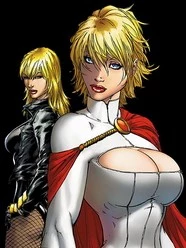 But it didn't take long for people to notice, and even less time for them to take advantage. In 1942, Wonder Woman appeared, bringing with her a treasure trove of S&M and control fantasies and legions and legions of copycat heroines. The impossible body proportions and skimpy outfits many mature readers complain about is not only old news, it may be innate to the idea of the superheroine. What more could one expect from an industry founded by "girlie mag" publishers like Harry Donenfeld?
But it didn't take long for people to notice, and even less time for them to take advantage. In 1942, Wonder Woman appeared, bringing with her a treasure trove of S&M and control fantasies and legions and legions of copycat heroines. The impossible body proportions and skimpy outfits many mature readers complain about is not only old news, it may be innate to the idea of the superheroine. What more could one expect from an industry founded by "girlie mag" publishers like Harry Donenfeld?
Eventually, comics will have to move to a more realistic, positive image of women simply to survive, and the companies know this. The Supergirl shorts-law is just the first shot in this direction. For now, though, sexually suggestive imagery involving female characters is all part of the shame, and intelligent readers have learned to ignore it and not let it ruin the reading experience. Flying scissor kicks, costumes with boob windows and heroine-on-villainess fight scenes are for now part and parcel of the superhero game, no matter how juvenile, clumsy, artless, pointless and laughable they may be.
Then "Detective Comics" comes along and does it right. And maybe this whole thing isn't so bad after all.The "Batwoman" feature in "Detective Comics" uses sexual imagery in a way that may not have been seen before in mainstream comics. Like William Moulton Marston's Wonder Woman, it takes advantage of the malleable language of comics to present two images at once: what is happening, and what is really happening. Wholly unlike Wonder Woman is the sense that Batwoman's odd sexual energy leads to a greater understanding of the story.
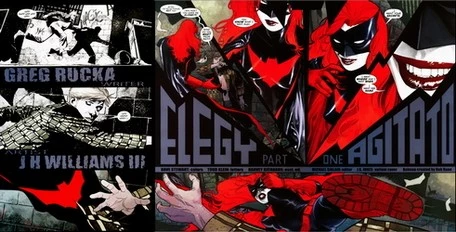
When Batwoman first appears, she bleeds an insignia of color into a black and white world, and then is suddenly everywhere at once. Artist J.H. Williams, as ever, has a rare gift to drag the reader into his vision, a sluggish fractal tilt to his work that hypnotizes. Batwoman is something to behold in her black latex suit and bullet bra, and she immediately begins doling out pain. She digs her bootheel into a street thug, beats him up, threatens him, degrades him. Just as quickly, in the last panel on page 4, the image softens and she takes on the role of benevolent savior, promising not to let anyone hurt him if he just whispers something in her ear -- a "safe word" if you will.
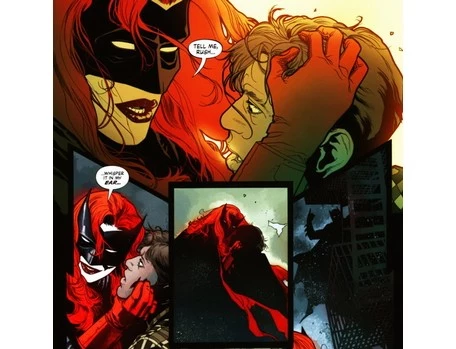
As her adventures continue in "Detective" 854 and 855, the reader is treated to an array of images that, while never explicit, hint at sexual acts and behaviors, typically in Batwoman's interactions with other women. She drags a female member of the Religion of Crime by the hair and bends her backwards. Note the suggestive placement of Batwoman's left hand.
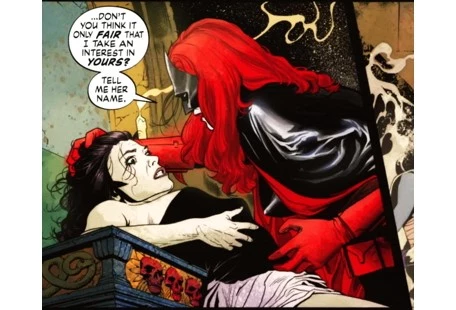
In her struggle with Alice, the new leader of the Religion of Crime, there are several panels that could easily be construed as sexual. As Batwoman leans in to removed Alice's sidearms, her hands are placed dangerously close to her breasts; she sneaks her hand in to relieve Alice of the knife strapped to her thigh, and Alice responds by licking at her lips.
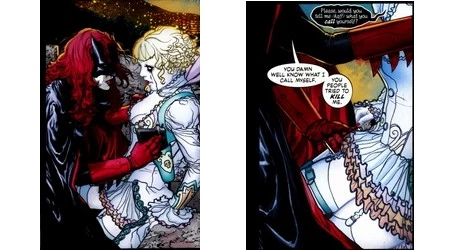
It can be argued that any panel can be taken out of context, unintentional, subject to the psychological whims of the readers and so on. That's an entirely different discussion. Just for fun, let's assume that all of this really is happening and that it's intentional. What would that mean?
Writer Greg Rucka is known for writing uncannily strong female characters. Through an unwavering commitment to the details he has built rich, compelling characters of Carrie Stetko, Tara Chase and Renee Montoya, and it looks like Batwoman, a.k.a. Kate Kane, will probably added to that list. When Kane first appeared in "52," most negative reactions to her sexuality were the usual ignorant message board fare, which is somehow both typical and surprising. Above the twisted snarl of a million mouth-breathing troglodytes, however, an interesting point was raised: isn't this just another male fantasy? The lipstick lesbian?
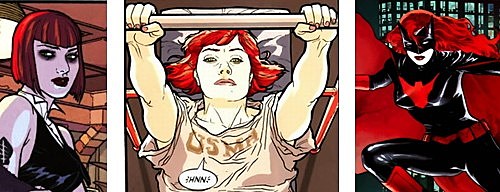
The Kate in "Detective" is far removed from the elegant socialite with familial guilt from "52." As the story transitions from Batwoman to Kate, Williams' art unscaffolds and breaks down into neat little boxes, as regimented and arranged as her life. After being stabbed in the heart, Kane seems to be in some sort of identity crisis, not entirely sure of who she is: the Suicide Girl personality with her soon-to-be-ex, the tomboy with her father, the soldier with the Airborne tattoo, or Batwoman. And the trauma of her injury seems to awaken old issues.
And this is where the theory gets really interesting...
One of the reasons Lewis Carroll's "Alice in Wonderland" has endured as a classic tale is its wild psychological resonance, as though it were specifically created to tickle the subconscious. The amount of interpretation put into its dreamlogic probably even rivals "Oedipus": there are entire college courses dedicated to its study. The details differ from opinion to opinion, but just about everybody agrees: It's about sex. Most seem to believe that it represents a pubescent girl's sexual awakening, and the strange world of pleasure and danger that awaits. Freud's analysis was that Alice was lesbian. Others still are convinced it's about abuse.

Did Rucka choose to introduce the "Alice in Wonderland" references to hint at further revelations? These hazy, washed out memories that appear – a girl with a sack over her head, a woman being torn away from her daughter, the soldier strapped to the chair – certainly give the theory weight. Is the sex in the images just a visual doorway into a discussion of sexual identity? Are the hidden words in pages 14-15 (855) given further significance? Are we in the rabbit hole?

Rucka and Williams are each rare, meticulous talents who don't seem to do anything accidentally. Is "Batwoman" manipulating our acceptance of sexist behavior in comics to portray the harm that it causes? Do I just need to get laid?
Really, it doesn't matter. (I'm cool) What matters is that it's good, good enough to get you thinking, and only exceptional work does that.
And if this is all crap, Rucka and Williams should adopt it as part of the legend anyway. That might get me laid.
More From ComicsAlliance


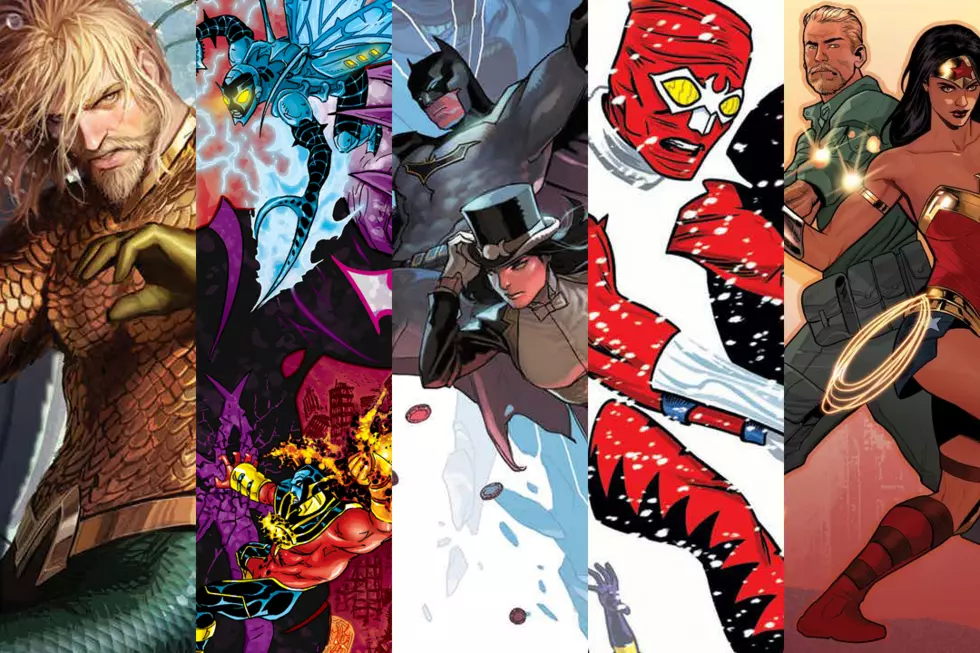
![‘Batwoman’ #1 Delivers A Globetrotting Gay Adventure [Review]](http://townsquare.media/site/622/files/2017/03/BW_featured.jpg?w=980&q=75)

![Comics’ Sexiest Female Characters (From A Queer Perspective) [Love & Sex Week]](http://townsquare.media/site/622/files/2017/02/hg_featured.jpg?w=980&q=75)
![The Bats Swoop Down In ‘Mother Panic’ #3 [Exclusive Preview]](http://townsquare.media/site/622/files/2017/02/MOPA_featured1.jpg?w=980&q=75)


